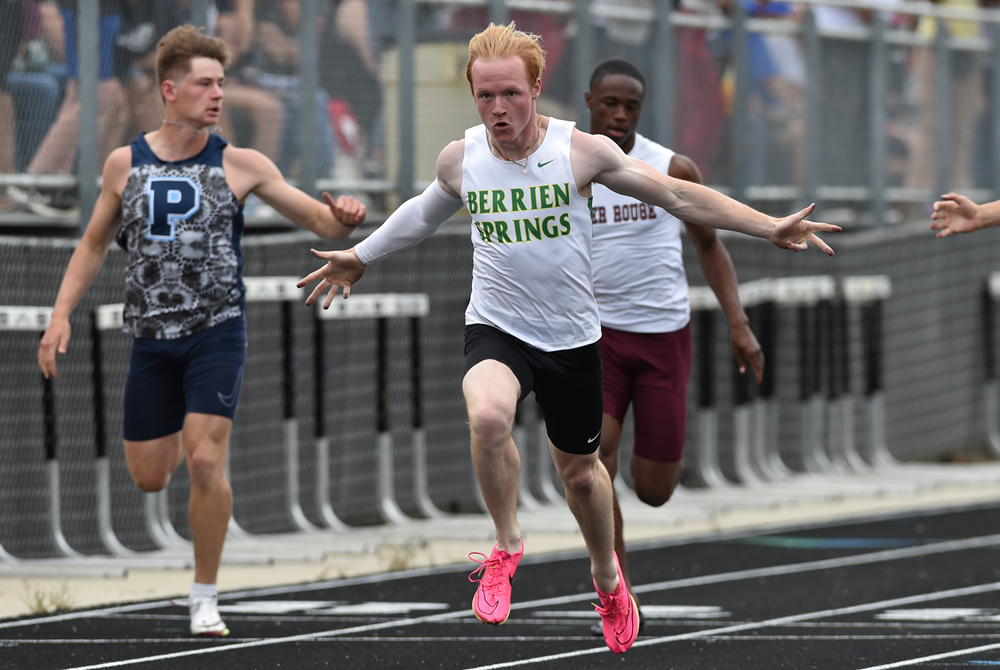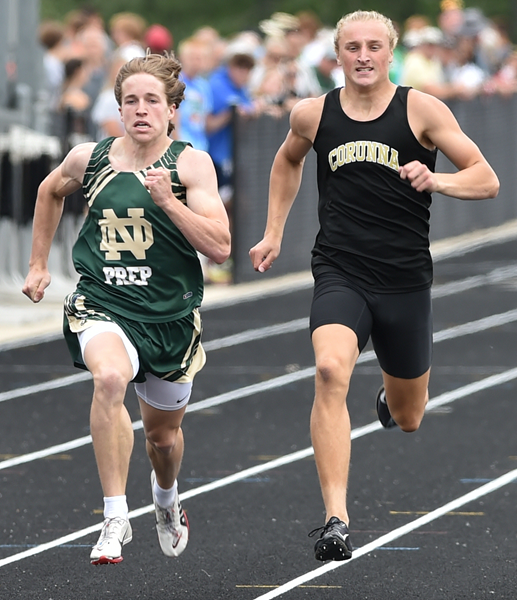
Classes Still Create Hoosier Hysteria
July 27, 2017
By Rob Kaminski
MHSAA benchmarks editor
This is the fourth part in a series on MHSAA tournament classification, past and present, that will be published over the next two weeks. This series originally ran in this spring's edition of MHSAA benchmarks.
Twenty years ago, Bloomington North High School won the Indiana High School Athletic Association boys basketball championship, defeating Delta 75-54 at the RCA Dome in Indianapolis.
The date, March 22, 1997, is at the same time revered and disdained by traditionalists in the state who saw it as the last schoolboy championship game the state would ever host.
That’s how devout the game of basketball, particularly interscholastic basketball, had become in the Hoosier state during the 87 years a state champion – one state champion, to be precise – was crowned.
Following that 1997 season, the IHSAA moved to a four-class system for its roundball tournaments, like so many of its state association counterparts had done years earlier.
It would be shocking to find more than a small percentage of current high school basketball players around the country unfamiliar with the iconic movie Hoosiers, even though the film is now more than 30 years old.
And, the storyline for that blockbuster unfolded more than 30 years prior to its release, when small-town, undermanned Milan High School defeated Muncie Central High School 32-30 in the 1954 IHSAA title game.
Perhaps it’s because of the David vs Goliath notion, or the fame of the movie that replaced Milan with the fictional Hickory and real-life star Bobby Plump with Hollywood hero Jimmy Chitwood, or the simple fact that Indiana had something other states didn’t.
Whatever the reason, plenty of opposition remains to this day to basketball classification in the state.
The fact is, the small rural schools were regularly being beaten handily by the much larger suburban and city schools as the tournament progressed each season.
Small schools also were closing at a rapid rate following the state’s School Reorganization Act in 1959, as students converged on larger, centralized county schools. From 1960 to 2000, the number of schools entering the tournament dropped from 694 to 381, and in 1997 a total of 382 schools and 4,584 athletes began competition at the Sectional level (the first level of the IHSAA Basketball Tournament).
It was at the entry level of the tournament where school administrators felt the pain of the new class system, but not necessarily for the same nostalgic reasons as the fans who either attended or boycotted the tournament.
At the Sectional round of the tournament, the IHSAA was culling just 2 percent of the revenue, with the participating schools splitting the balance. So, when Sectional attendance dropped by 14 percent in that first year of class basketball, many schools realized a financial loss. It was money they had grown to count on in prior years to help fund various aspects of the department.
Schools cumulatively received more than $900,000 from Sectional competition in 1998, but that total was down from more than $1 million in the last year of the single-class tournament.
Yet, the current format provides a great deal more opportunity and realistic chances at championship runs for schools of all enrollments.
To date, 60 additional teams have championship or runner-up trophies on display in school trophy cases around Indiana.
That was the mission in front of then-IHSAA commissioner Bob Gardner (now National Federation executive director) once the board made its decision: to give thousands more student-athletes the opportunity for once-in-a-lifetime experiences.
As any statistician knows, figures can be manipulated to tell any side of a story. Declining attendance in year one of class basketball is such a number.
The truth is tournament attendance had been on a steady downward spiral since its peak of just over 1.5 million in 1962. By the last single-class event in 1997, the total attendance was half that.
The challenge then and today, as it is for all state associations, is to find that delicate balance for those holding onto tradition, those holding onto trophies, and the number of trophies to hand out.
Editor’s Note: Stories from the Fort Wayne Journal Gazette in 1998 and from a 2007 issue of Indianapolis Monthly provided facts in this article.

Machiniak Sets Pace as Berrien Springs Edges Corunna in Matchup of Recent Champs
By
Scott DeCamp
Special for MHSAA.com
June 1, 2024
HAMILTON – After a rainy afternoon Saturday, the precipitation let up long enough for Berrien Springs’ boys track & field team to put the finishing touches on another MHSAA Lower Peninsula Division 2 Finals championship.
After Shamrocks head coach Jon Rodriquez collected his program’s second team title in three years, rain fell again at Hamilton High School’s Hawkeye Stadium, only heavier this time.
The reign returned for Berrien Springs.
“It feels great, man. It’s hard to say what it feels like,” said Shamrocks senior standout Jake Machiniak, who sprinted to first-place finishes in the 100- and 200-meter dashes plus anchored winning 400 and 800 relays.
“This team, they worked all offseason. This is the hardest group of workers I’ve ever had. All these guys, all the guys that scored, they’ve all come year-round. The relays, we performed. I performed in the opens. It’s great. It’s a great feeling, man. Two times, man. Two times. Second time winning the state. It’s fantastic, man.”
Machiniak, a Grand Valley State University commit, repeated in the 100 with a time of 10.74 seconds. He won the 200 in 21.76 seconds in addition to running the closing leg on Berrien Springs’ first-place 400 relay (42.13) and victorious 800 relay (1:28.24).
Machiniak powered Berrien Springs to 40 points as a team, allowing the Shamrocks to edge runner-up Corunna (38 points), the 2023 champion. DeWitt was third (34) and Charlotte fourth (28), followed by Pontiac Notre Dame Prep and Parma Western tied at fifth (26).
Last year, Berrien Springs tied for seventh, which fueled the Shamrocks’ hunger all offseason.
“Jake was on that team two years ago. He ran the 4x100 for us,” Rodriguez said. “We’ve kind of had our eyes on this the last two years. Last year we fell short a little bit, and this year the kids were hungry. They worked their butts off all year long, running in the summertime, running in the hallways in the wintertime, just getting ready for this moment. It’s awesome. It’s awesome to see.”
In the 400 relay, Machiniak was joined by Zander White, Samuel Magesa, and Kameron Autry. In the 800, it was Magesa, White, and Noah Jarvis.
Notre Dame Prep senior Zachary Mylenek took first place in the 400, finishing nearly a second better than his personal-record time of 48.49 seconds, and he was runner-up in the 200 (with a personal season-record 21.92).
Bound for Purdue University, where he plans to study mechanical engineering and perhaps walk on to the Boilermakers’ track team, Mylenek also anchored Notre Dame Prep’s seventh-place 1,600 relay team.
 He adapted to his circumstances and performed at a high level.
He adapted to his circumstances and performed at a high level.
“The rain sucked, but I’ve been fortunate enough because we’ve been running in the rain a lot this year and I ran last year in it,” he said. “I just ran my race and other guys, I was listening, they don’t like running in the rain. It’s a mindset thing, and I just dialed in.”
Grosse Ile junior Sam Vesperman repeated in pole vault with an effort of 14 feet, 7 inches.
Vesperman was not expected to win last year, and he pulled it off. Being ranked No. 1 in pole vault coming into Saturday’s meet created more pressure for him.
“It was definitely different because I was projected to win it (this season),” Vesperman said. “Last year I was the second guy, right – I wasn’t the big name. It was definitely different having everybody (saying), ‘Oh, that’s the guy to get, so … .’”
Vesperman’s official personal record in pole vault is 15-3. On Saturday, he was pushed by Whitehall senior Ca’Mar Ready, who turned in a PR effort of 14-4, but Vesperman was able to execute when needed.
“Yeah, it’s really nice to win, but we just keep chasing that next bar, that next height. That’s definitely the motivational factor,” Vesperman said.
Other event winners included: Clio’s Elliott Sirianni in the 800 (1:55.09 PR), Freeland’s T.J. Hansen in the 1,600 (4:11.31), Pinckney’s Paul Moore in the 3,200 (9:07.53), Grand Rapids Catholic Central’s Mill Coleman in the 110 hurdles (14.49), Charlotte’s Cutler Brandt in the 300 hurdles (38.48), Coopersville’s Gabe VanSickle in the shot put (61 feet, 2 inches), Wayland’s Adam Huff in discus (172-0), and Stevensville Lakeshore’s Declin Doroh in high jump (6-7) and Kaden Griffiths in long jump (22-9.25).
Hamilton won the 1,600 relay (3:23.40), while Marshall took first place in the 3,200 relay (7:48.49). Chelsea senior Jacob Nelson won the 100, 200 and 400 adaptive events.
Rodriguez started coaching at Berrien Springs in 2012, and he became head coach in 2014.
He said the Shamrocks improve in practice because there’s a lot of competition. Everybody is chasing Machiniak.
“I mean, we have Jake Machiniak, one of the top sprinters in the state, in practice and the kids want to beat him. They don’t just want to just, like, run with him; they want to try and beat him, so that competition in practice has been huge,” Rodriguez said.
“I’m just very proud of them. We showed up on the days that were important. On a big meet like this, it’s about being your best today – we had our best on the best day.”
Like Vesperman, Machiniak entered the 2024 season with a lot of pressure. He noted, however, that the only way to improve is to put oneself in pressure situations.
Machiniak said this team title feels better than the one won in 2022 because he played a bigger role. There’s strength in numbers, though, and Berrien Springs has been known to possess depth, especially in the sprints.
“That’s all Coach Rodriguez. Best coach in Michigan – it’s not even close,” Machiniak said. “He has us training in the offseason. He has us training winter, summer, spring, fall – all the time, man. We have a lot of guys at the state meet that come (put in the work) in the offseason, all year round. Year-round athletes that do speed training. As far as the sprints, that’s all Jonny Rodriguez – best coach in the nation.
“This group, I’ve grown up with this group, man. I’ve known these guys for a while. I’ve grown with them, I’ve trained with them, I’ve cried with them. You know, these are the guys that I’ve grown up with.”
PHOTOS (Top) Berrien Springs’ Jake Machiniak, second from left, crosses the finish line first in the 100 during the Lower Peninsula Division 2 Finals on Saturday. (Middle) Pontiac Notre Dame Prep’s Zachary Mylenek, left, and Corunna’s Wyatt Bower race to the finish in a 200 prelim. (Click for more from Dave McCauley/RunMichigan.com.)

